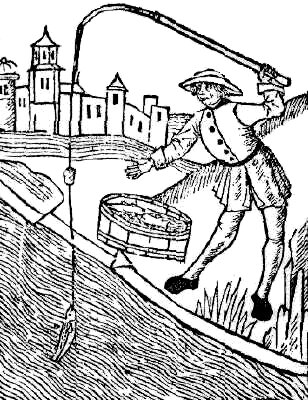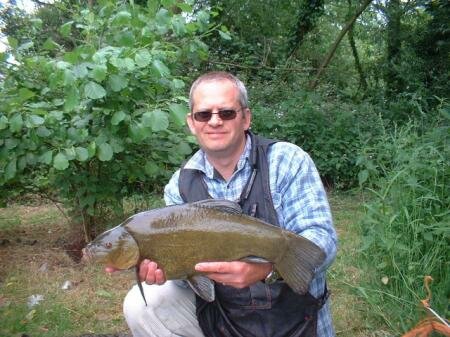Nothing New
Middle of my usual spring hiatus so I thought I'd post up my latest article for one of my club's (NAA) quarterly newsletter...

Nothing New!
Walk into any tackle shop or browse any bait catalogue and the variety of baits and flavours for sale can be bewildering to the novice (and the more experienced) angler. The Hinders online store, for example, offers over 500 different choices of pellet, particle, boilie, wafter, flavour or glug with the promise of more 'in store'. What to buy when they are all so reassuringly expensive? How is one to decide when they all promise so much - the amount of choice is quite simply, overwhelming!
Some might hark back to simpler times when bait preparation meant digging in the back garden for a supply of worms or putting a few slices of bread in your bait box as you walked out the door. However, I doubt those days ever existed. Bernard Venables writing in Mr Crabtree Goes Fishing, for example, lists 16 different baits for chub including, ‘the pith from the spinal cord of a bullock'. Try asking your local butcher for that today! Even as a youngster – when gentles were beyond the means of my meagre pocket money I used to raid my mother’s kitchen for food dye and custard powder to make paste. And I once made up some parmesan boilies which I was convinced the local chub would find irresistible – alas, they didn’t!
One unusual bait I did try very successfully was suggested to me by a 500 year old book - the very first printed book on angling (in English) no less. If Izaak Walton is the Father of Angling then Dame Juliana Berners can be said to be the Mother. Who? Well over 150 years before The Compleat Angler was published, Dame Juliana is credited by many with writing A Treatyse of Fysshynge wyth an Angle, which was published as part of the second edition of The Boke of St. Albans (a book on hunting) in 1496. Whilst some scholars dispute Berners very existence there's little doubting these are the earliest printed words on Angling, having been produced by William Caxton's apprentice, Wynkyn de Worde. What evidence there is for Berners (or Barnes or Bernes - there are numerous spellings!) existence points to her being The Lady Prioress of Sopwell, a Nunnery near St. Albans. Whatever the truth of the matter, the Treatise stood for over a century, as the definitive 'how to' manual for the Tudor angler. The work was also, undoubtedly, 'source material' for ol’ Izaak who plagiarised much of it for the Compleat Angler a century and a half later.
At the end of the15th Century you couldn’t just pop down the local tackle shop if you wanted to take up angling, so the slim volume covers everything from building your own rod, twisting and dyeing your own lines, advice on making your own hooks and floats, shotting patterns, bait recipes, tactics for each different species, even 12 fly patterns for trout. All this described in under 9000 words. When it comes to baits in the book there are descriptions of various bugs, grubs, worms and snails etc and where to find them at what time of year – there’s a lot of looking under ‘cow turds’!
Many years ago, when I first read the Treatise, one line in the paragraph on tench, piqued my curiosity, viz: ‘And for the best bait take the black blood from a sheep's heart and flour and honey; moisten them with water until a little softer than paste.’ When I read that I thought that sounded an awful lot like black pudding and vowed to give it ago on my next tench trip.
Black pudding (least the stuff I bought!) needed a bit of preparation – I sliced and fried it to give it a tough enough skin to stay on the hook. It made its debut on an early June morning in 2003. The result was instant success – my first tench on it was a 7lb 10oz specimen – still a PB over 20 years later – that’s one way to get instant confidence in a bait! As a consequence I used black pudding a LOT for my lake fishing for the next 3 or 4 seasons. I found it very discriminating in that I would catch plenty of tench and very little else – apart from the odd carp. One fantastic June morning in 2005 I caught 12 tench on it with half of those being over 6lb – my biggest that morning was 7lb 8oz – the closest I’ve come to bettering that PB of a couple of years earlier.

I even tried it on the river a few times – thinking the Kennet barbel would like it, alas not – I didn’t catch a single one on it – I didn’t even get many chub either. It appeared that whilst tinca tinca loved black pudding other species were not so keen and I never caught a crucian on it either despite fishing waters with an abundance of them! Seems the Tudor’s knew a thing or two about tench baits!
The proliferation in the variety of baits for the angler must have escalated further by the17th century as Izaak Walton himself commented "as for pastes, there are almost as many sorts as there are medicines for the toothache". The Compleat Angler is said to be the 2nd most published book in the English Language (the first is the bible!). First published in 1653 it was added to and re-issued several times in Izaak’s own lifetime (the 5th edition was published in 1676) and has never been out of print since. Yet how many of today’s anglers have actually read it? I must admit the early chapters are a bit ‘flowery’ and off-putting but if you turn to the species specific chapters there is still much to intrigue the modern angler. None more so than the bait recipes!
There are numerous paste recipes in the book – with honey featuring quite a bit as an additive. Cheese is also recommended frequently for example strips of toasted cheese attached to the hook with silk thread is advocated for barbel, which also suggests an early form of bait band or even hair-rig.
It is no surprise that, just like it would today, a lot of the chapter on carp is taken up with a discussion on baits and flavours and this recipe for making your own paste for the species always raises a smile with me!
"And your paste must be thus made: take the flesh of a rabbit, or cat, cut small; and bean-flour; and if that may not be easily got, get other flour; and then, mix these together, and put to them either sugar, or honey, which I think better: and then beat these together in a mortar, or sometimes work them in your hands, your hands being very clean; and then make it into a ball, or two, or three, as you like best, for your use: but you must work or pound it so long in the mortar, as to make it so tough as to hang upon your hook without washing from it, yet not too hard: or, that you may the better keep it on your hook, you may knead with your paste a little, and not too much, white or yellowish wool. And if you would have this paste keep all the year, for any other fish, then mix with it virgin-wax and clarified honey, and work them together with your hands, before the fire; then make these into balls, and they will keep all the year."
At last a use for your cat and if not boilies perhaps they would have been called bakies!
To finish I’d like to return to The Treatise which itself ends on two very 'modern' themes, proposing an early countryside code...
"Also, I charge you, that you break no man's hedges in going about your sports: nor open any man's gates but that you shut them again."
And making a plea for conservation of fish stocks...
"Also, you must not be too greedy in catching your said game as taking too much at one time... Which could easily be the occasion of destroying your own sport and other men's also."
Some things never change!
The Treatise and the Compleat Angler are both available to read online for free. Finding a modern English translation of the Treatise can be a little tricky – though you can read it here (but without the woodcut illustrations): https://vault.si.com/vault/1957/05/20/the-treatise-of-fishing-with-an-angle . A facsimile of the original with illustrations (but in the old English) can be read here: https://www.luminarium.org/renascence-editions/berners/berners.html (Folks who know me from Anglersnet may recognise the woodcut on the frontispiece – I use it for my avatar!).
The Compleat Angler is easy to find online – the 5th impression can be read here for example: https://www.gutenberg.org/cache/epub/683/pg683-images.html and a facsimile with the additional chapters on fly fishing by Charles Cotton here: https://scholarsbank.uoregon.edu/xmlui/bitstream/handle/1794/773/angler.pdf
Edited by Chris Plumb


0 Comments
Recommended Comments
There are no comments to display.
Create an account or sign in to comment
You need to be a member in order to leave a comment
Create an account
Sign up for a new account in our community. It's easy!
Register a new accountSign in
Already have an account? Sign in here.
Sign In Now